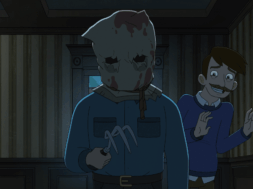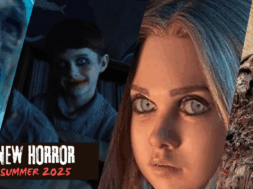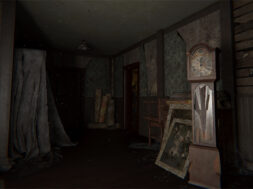‘Alpha and Omega’ is a recurring feature that examines a famous horror director’s best critically received film and their worst reviewed installment (according to Rotten Tomatoes). It will compare and contrast these two efforts, looking at the difference in the auteur’s work and seeing if any overlap exists as these two extremes of the director’s career are examined.
We get bloody with Dario Argento’s arguably best and worst films, the tautly terrifying Deep Red and the dead-on-arrival Dracula 3D.
“I can feel…death in this room. I feel a presence…a twisted mind.” – Deep Red
“You must be famished.” – Dracula 3D
Italian filmmakers have held a certain stranglehold on the horror genre due to their extreme take on the bloody medium, but amongst the many acclaimed Italian directors that come up in the conversations about the canon of horror, Dario Argento is a name that’s typically at the top of the list. Argento is responsible for such fundamental horror films as Phenomena, Inferno, and of course, Suspiria. These are films that have left such a mark on the horror industry that many modern filmmakers are still paying reference to them now. They’re obsessed with these movies and still trying to top them to this day.
Deep Red is Argento at his most inspired and experimental and Dracula 3D sits comfortably at the opposite end of that spectrum. The latter sees the director explore new (and unnecessary) technology and it’s a lifeless effort that feels more for a paycheck than the desire to get out a compelling story. Curiously enough, both Deep Red and Dracula 3D deal with someone trying to hunt down a serial killer, whether it’s an out of his league pianist who wants to solve the identity of a murderer or the acclaimed Van Helsing’s attempts to extinguish the legendary Dracula. So while these films are wildly different in subject matter and tone, they do both carry this common throughline that does oddly connect them. This “Alpha and Omega” will examine Deep Red (which currently has a 95% on Rotten Tomatoes) and Dracula 3D (which currently has a 14% on Rotten Tomatoes), and examine the expansive differences and limited similarities between the films, plus how they chart Argento’s changing sensibilities as a filmmaker.
Deep Red is the fifth film in Argento’s oeuvre and while his first three movies were huge successes, this one really goes for broke and ups everything that Argento loves and excels at in filmmaking. Had he not cut his teeth and experimented with Suspiria or Inferno, then Deep Red likely wouldn’t be as brutal of the experience that it is, It’s a heavy movie, but it’s also why it’s such a notable horror film and widely considered to be this horror auteur’s finest work. This deranged story is one of the best examples of Argento combining elements of horror, mystery, and thriller, and it’s still one of the best, most formative giallo films to this day nearly 50 years later. Curiously, Deep Red was released in Japan as Suspiria 2, even though they share no connection and Argento made Deep Red before Suspiria.
Deep Red concocts a brilliant premise where a psychic ends up inadvertently reading the mind of a murderer within his audience and then finds himself a victim. A pianist of all people winds up as the one attempting to solve these murders, but he continually falls behind when the killer keeps on adding to his body count. Deep Red is a film that’s driven more by its death scenes and the fantastical set pieces that surround each of them, rather than a complicated plot. This is a reasonably simple cat and mouse story, but Argento turns each murder into such a creative spectacle in a way that might be commonplace now thanks to films like Scream or Final Destination, but Argento gets twisted with his kills years before the curve. Not a single death is “wasted” here. In spite of its simplicity, Deep Red still tells a much more complex, interesting story than what’s present in Dracula 3D. It ties its themes together well and while the movie is much more style over substance, it’s far from lacking in substance. Dracula 3D, on the other hand, is 0-2.


Right from the start, Deep Red succeeds in grabbing the audience’s attention with an opening scene that is both brilliant and eye-opening. It could seriously be released on its own as a micro short film called something like “Seasons Greetings” and be a gem on its own. The scene depicts a grisly murder that takes place at Christmas. The entire sequence is depicted through silhouette and then the murder weapon casually falls into frame. No full person, murderer or victim, is ever seen and all the while sweet nursery-like children’s music scores the whole thing. This innocent affectation even becomes the killer’s signature move and a crucial clue. The music is repeatedly played before moments of chaos. Not only that, but this scene literally interrupts the opening credits. It’s a jarring maneuver that puts the audience off guard, just like the characters in the film, and it’s crazy how much more effective this is than simply running the scene after the credits are complete.
Deep Red succeeds not just as a major influence on giallo cinema and slasher films in general, but it also helped usher in many more surreal and avant-garde productions in the horror genre. Argento helped prove that this could be a viable, successful approach and Deep Red is the strongest example of this. The film utilizes the first person perspective of the killer before the audience knows their identity, which is a technique that it feels like John Carpenter pays service to in Halloween. Furthermore, the dreamy aesthetic of the film also feels present in works like Wes Craven’s Nightmare on Elm Street or Don Coscarelli’s Phantasm. Brian De Palma’s classic, Dressed to Kill, pulls from a lot of classic films, but it’s hard to see it existing without Deep Red coming before it.
The film’s score, by Giorgio Gaslini and the Goblins (who always kill it when it comes to Argento films), is also a consistent highlight. It’s like a fusion of Morricone and Carpenter music that leads to a sublime creepy mix. The film’s protagonist, Marcus Daly (David Hemmings), is also a jazz pianist and so Argento cleverly weaves frantic jazz music into the score during moments where the character needs to spring into action. There’s also a wealth of children’s music mixed into the film, which presents an unsettling juxtaposition to all of the violent murders that take place during it all.
While the film’s score helps set the tone, Deep Red’s cinematography is on a whole other level. The introductory scene that takes place at a band rehearsal is filmed with a Hitchcockian voyeuristic eye. The camera floats through the scene and captures each of the members of the group before it slowly zeros in on Marcus and establishes his importance as the film’s protagonist. The camera continues to fly through scenes like it has a mind of its own or as if it’s some lost spirit that’s roaming the scenes of the film. The camera moves with such deliberate fluidity that it adds a certain tension to the film that also benefits Argento’s story. For instance, at one moment where Helga Ulmann, a strong psychic, talks about the powers of telepathy and the human mind, the camera slowly pushes in on the back of her head—specifically her brain—as if it underline and highlight the “star” of what she’s talking about to her audience.


Deep Red also works hard to obscure the killer’s face in ways that are artistic and unique rather than manipulative or derivative. The killer also sports the traditional black leather murder gloves because Argento is a traditionalist when it comes to his giallo horror.
There’s also plenty of first person POV work when it comes to the killer stalking his prey, which finds a real sweet spot. However, the film goes one step further here by how it takes its time to fetishistically look over the many toys of children, which act as the killer’s trophies for all of his handiwork. It’s quite the powerful, unnerving sequence that keeps the killer a mystery in a way that’s important for the film.
There’s a moment early on where Marcus and his insensitive drunk friend hear the murder of Helga Ulmann take place. The sound of her scream causes the camera to snap from a medium shot of these two into an extreme wide shot of the entire community. It’s a cinematic way to indicate that the scope of the scene has suddenly shifted from some personal conversation to a much larger problem and it’s brilliant. The scenes where characters are supposed to be caught in some kind of psychic trance cast characters or objects against stark black backgrounds, almost like they’re lost in space or nothingness itself. It’s a technique that will be used decades later to similar effect for the hypnosis scenes in Jordan Peele’s Get Out, but it’s fascinating to see Argento establish such simple staples of the genre.
In Deep Red Argento allows the camera to push into ballrooms, get through windows, and it’s clear that while Marcus may face obstacles through his journey, the camera—and by extension, the killer—are free and untethered. There’s such intention to the composition and mise-en-scene of every sequence, whereas Dracula 3D languishes through direct, static shots. Dracula 3D looks boring and normal. It features none of the sprawling, tracking shots that the director is known for. It’s basically stationary setups through the entire movie.
There’s a particularly masterful sequence of suspense where Marcus plays piano in his home and suddenly realizes that the killer is in his home. Marcus continues to play the piano so as not to let on to this stalker that he’s aware of their presence. With Marcus stuck at the piano, the camera is the only one that gets to move in the scene and it creates a scene that’s just as intense as if the killer were actually in frame the entire time. This eeriness continues throughout the film and there’s a persistent feeling that Marcus is being watched.


An even more troubling scene is when Amanda stumbles upon the collection of hanging baby dolls that are littered throughout her home. It’s seriously frightening stuff and it continues the film’s theme of the perversion of childlike imagery. The reveal of the totally obscured killer in Amanda’s closet as a sole eye blinks in the darkness is equally chilling and the murder that follows is another messy, brutal affair. If all of this wasn’t enough, the killer takes the unconscious, beaten body and then proceeds to drown her in boiling hot water. Argento once again goes for broke here and puts to use very realistic, rather than over the top, burn effect. The crown jewel of all of this is the mechanical puppet that’s present during Professor Giordani’s murder. It’s a deeply disturbing encounter and feels like something that Jigsaw would use, yet this predates the Saw films by decades. This scene is likely the best example of the killer’s array of childlike tools that he uses to harass his victims.
In spite of all of the terror, the film does have a rather interesting—almost slapstick at times—sense of humor, so it’s not focused entirely on fear. Additionally, Dracula 3D goes too far in this department and dips into camp, whereas Deep Red’s humor is to help develop the characters and cleanse the audience’s palate from all the murder (although the moment where Marcus almost falls off a building gets pretty close to camp thanks to the bizarre score that’s present).
Deep Red enjoys playing with its audience and their expectations. For instance, there’s a fake-out that’s very much in the same style as Psycho during the beginning of the film where it looks like Helga will be the protagonist and use her psychic powers of the mind to take on the killer. However, much like Marion Crane in Psycho, Helga’s ostensibly the film’s first victim and merely collateral damage, not the movie’s central point of view. Dracula 3D doesn’t attempt anything nearly as ambitious—not that it would necessarily be a good idea with that sort of story—but it allows Deep Red to be a lot more unpredictable and entertaining of a narrative. It makes everyone feel disposable and worthy of execution.
Another clever way in which Argento attempts to help American audiences out is by the decision to make Marcus an English character who’s abroad in Italy. He very much becomes the audience surrogate and a familiar reference point that it’s easy to identify with. This element certainly isn’t necessary, but it’s a nice bonus that adds another layer to the film that is once more absent in something like Dracula 3D.


As Marcus’ investigation heats up, he finds a partnership with Gianna Brezzi, a reporter. Gianna and Marcus have some very fun chemistry that almost makes the film feel close to something like His Girl Friday at times, which is never a bad thing. They’re a good, unconventional pairing for a horror film and they develop a real slapstick-y banter throughout the picture. At one point Marcus even has the audacity to tell Gianna, “Men are fundamentally different than woman. Women are…weaker. Gentler,” so clearly these two have quite the cantankerous love-hate relationship throughout the film. They literally arm wrestle in order to assert dominance and then bicker over the results. Can you imagine if Ed and Lorraine Warren from the Conjuring films had to arm wrestle to determine who deals with the spirit or if Rocky and Alex from Don’t Breathe had arm wrestled to figure out who goes in the house first? However, in the case of Deep Red, this speaks to the very clear lines that it draws in the sand regarding gender. Right after Gianna beats Marcus at arm wrestling, she tries to make plans with him to come over for sex.
It’s significant to point out that in spite of this skewed power dynamic that’s intentionally present, the victims are not entirely women. Of course, the killer also turns out to be a woman, which not only subverts all of this, but shows that women can be powerful—albeit damaged—too. It’s worth pointing out that it’s the killer’s necklace that ultimately kills her in the end, too. A man wouldn’t have met their grisly end if in the same situation, which seems significant. Furthermore, it’s amazing to see that arguably Argento’s most popular villain is the immortal witch and her coven from Suspiria, but here it’s simply an over-protective old mother who has space issues with her son. It’s meant to be an underwhelming answer that’s exceedingly human, but it speaks to how Argento can make even the most mundane of things terrifying. Marta is up there with some of Argento’s most frightening monsters and it’s shocking how an elderly woman is more threatening and holds more weight than Count Dracula himself.
On that note, all of the murders in Deep Red are entertaining and they gleefully play into the over the top, theatrical nature of giallo death scenes. The women victims scream and throw their arms into the air when they find themselves in danger and the killer always swings his hatchet or blade with his full strength as it messily plunges into his victim. It’s the most impractical, clumsy way of killing someone, but it’s also the most operatic, which is what this style of horror is all about. There are often murders here that go above and beyond, like a victim who gets stabbed and then their falling corpse impales itself on broken glass. If it were possible to “double murder” someone then most of the victims in Deep Red would be guilty of such a tragedy.
On top of the gore, the film really weaves an exceptional mystery together. There are major clues given right from the opening scene, all of which make much more sense after the killer is revealed at the end of the film. An intelligent, well-plotted mystery takes place and the film knows when to parse out evidence and backstory on the killer to make all of this work, but still be subtle. Moments like when Amanda’s message is written in the steam on the mirror or when Marc digs behind the wall in the “haunted house” to find the killer’s childhood drawings are great, smart revelations. It’s a film that was effective in the ‘70s and it still not only holds up now, but also continues to be referenced in horror to this day.
Furthermore, the reveal of who the killer is does come as a surprise, but it also makes sense. Finally there’s peace, only for the film to pull the rug out from under the audience one final time and unveil the real killer, Marta. That being said, the way that Isidore—the red herring—dies is so absolutely random and unearned that it’s hard to exactly take it seriously. It’s totally by chance and the freak sequence of events just as easily could have happened to an innocent person. However, it is awesome and it’s hard to believe that such a ridiculous solution was allowed into the film in the first place. The last twist that the film goes out on is genuinely surprising and a bold, unbelievable way to end the film.


Finally, Deep Red, also happens to hold a special significance for Argento as it openly comments on the second-wave feminism that was on the rise at the time in the ‘70s as well at the political and social turmoil that was present in Italy during the time. Deep Red functions as an exceptional horror film without any knowledge of these greater social themes, but Argento tries to say something with this picture and comment on the changing times. Dracula 3D holds no deeper significance or ties together to some important event from Argento’s life. It’s a studio’s shallow attempt to cash in on a trend because they think vampires and Dracula are popular at the moment.
Technically Argento’s take on Phantom of the Opera from 1998 has just as unfavorable as a reputation as Dracula 3D, but the latter feels like the more interesting of the two films to examine. It’s worth pointing out that both of these films where Argento tries to breathe new life into classic characters from horror are examples where the director totally strikes out. This certainly reinforces the fact that Argento is better off with original material rather than updating older works, even if he’s got a creative slant to the project.
Dracula 3D was made in 2012, nearly 40 years after Deep Red came out, so if nothing else it’s pretty damn impressive that Argento’s career is so expansive and that he’s still putting out content. Much like how the later films in Carpenter or Craven’s career started to find an unfortunate mediocrity, Argento’s later work also lacks the definition and bite of his earlier films. That being said, the director remains a master of cinema and is still capable of incredible imagery and an eerie atmosphere that remains to be one of a kind, it’s just not present here. Admittedly, while the later films in Carpenter, Hooper, and Craven’s careers are all pale shadows of what these auteurs are capable of, they still feel like films made by those directors. They carry their voices, for better and worse. Dracula 3D has no voice at all, let alone one that belongs to Argento, and that’s what hurts it the most.
Dracula 3D is everything that you’d expect from a Dracula film, with nothing new added to the mix and with absolutely no flair or passion for the material. It checks off the necessary boxes and calls it a day and it’s an extremely disappointing effort from Argento. It feels like a film from another era and filmmaker entirely. Everything happens so lifelessly, like Argento himself is directing from a coffin. It’s a mystery why any of this gets made. It seems like Argento just wanted an excuse to showcase his daughter (who’s also ultimately wasted here) and to get to film a ton of nudity (which includes his daughter). This film could just be erased from history and absolutely nothing would be lost. The rest of the Dracula and vampire films cover all of this, and better.


Argento should have attempted to get bold and ambitious here because he’d be able to get away with it. He’s earned it and he’s Argento. Instead what he does is make exactly the sort of film that proves that he’s no longer relevant and out of his game. Mel Brooks’ Dracula: Dead And Loving It shows more originality and looks better than this! Argento also moves the story from Transylvania to England for no real reason and not only that, but this iteration of Dracula paid the entire town to stay quiet about him, whereas any other version of Dracula would just murder or threaten the entire community.
The film immediately begins on the wrong foot, as its opening credit sequence is so low quality and laughable. It feels like it was made in Windows Media Maker and it sets an extremely hokey, tone and low expectations for the film. It couldn’t be more different than the stark way in which Deep Red begins. Additionally, the high definition, ultra-focused look of the film in order to accommodate the gimmick of 3D also just makes the film look relatively ugly, which is usually at least the one area where Argento never disappoints. There’s a shiny, washed-out quality to the movie that lacks the grit and voice of Argento’s formative work. Scenes indoors even end up looking like they’re on stages and emphasize the artifice of the confined spaces. All of this is set to the film’s entirely forgettable score, which feels like stock music from a Halloween library. It’s all the more painful when put in comparison to the Goblins’ work on Deep Red.
There’s also an abundance of unimpressive CG where there doesn’t need to be and it just pulls you out of the experience. Dracula 3D, for instance, uses a CG owl in one scene, but Deep Red involves multiple real birds to much more intricate effect. There’s a CG wolf present in one scene that’s so comical. Like he looks like he’s from a DreamWorks animated film. The dusting effects for dead vampires also look worse than season one of Buffy. The biggest abomination here is when Dracula inexplicably turns into a massive CG praying mantis to devour his victim! The creature looks like a monster from a PS2 game, but it’s also, unfortunately, the only original idea that Argento brings forward in this film. Naturally, this mantis is never addressed again or explained, which almost makes the audience think that it maybe never happened in the first place.
Another puzzling decision that the film makes is that the main character is essentially Lucy (Asia Argento), Jonathan Harker’s betrothed, who just gets thrown from one discovery to the next rather than exhibit much agency. The film’s take on Jonathan Harker is such a bland, uninteresting character, too! He’s such a cliché and a terrible take on how men are powerless and slaves to sex. Argento should have just focused on Old Man Helsing and made that the focus instead. Even Dracula (Thomas Kretschmann) himself is pretty lame here. Sure, he holds a certain gravitas, but he’s hardly memorable. I’d prefer someone’s who’s hopelessly over the top than a performance that just plain disappears.

Dracula also practically immediately turns Harker into a vampire, with absolutely no explanation or build up to it, so his pained metamorphosis mostly falls flat. It’s actually a rather inspired idea to take an older, grizzled Van Helsing with Rutger Hauer in the role, rather than a young take on the character where he’s at the top of his game. Not only that, but Helsing only shows up in the final act of the film and mostly feels like Argento went, “Oh right, that’s a character that I can use, too!” and throws him in at the last minute.
The Dracula mythos typically has some sexiness woven into it, but Argento goes overboard here and really amps up the titillation. There’s so much full-out sex and nudity present here, like as much as possible, and it doesn’t hold back, so there’s that at least. It feels like some overindulgent pulp version of the Dracula myth, but it’s unclear if anyone exactly needed that. All of the danger that takes place is so manufactured, forced, and mostly disconnected from the main story. The movie also wastes about a half hour before Harker even arrives at Dracula’s castle. Why not just start the film with his arrival and save some time? The film is 15 minutes shorter than Deep Red, but it feels a half-hour longer. The only material that’s slightly interesting is Dracula’s psychic powers that are occasionally on display, but that’s still being very generous.
Dracula 3D demonstrates an unusual sense of humor and really plays into comedic sensibilities. Some scenes are even more interested in generating laughs than they are horror, which is an unusual dynamic for Argento to play into so strongly here. On the opposite end of that spectrum, Deep Red benefits from the suspense that it generates over its mystery of who the serial killer is whereas the majority of the action in Dracula 3D is already spelled out for the audience. The film just moves towards inevitable plot points based on who the characters are.
Dracula 3D is also, unfortunately, the last film that Argento has turned out and while there are far worse films to bookend a filmography, it’d be nice if Argento could still turn out one more winner so his final picture is something more personal than a trite, uninspired take on the most popular vampire of all time. Argento remains a master of his trade and even when he strikes out there’s something valuable that can be learned. Deep Red and Dracula 3D manage to highlight the exaggerated director at his best and worst, but they’re both bloody affairs that deserve a viewing.











